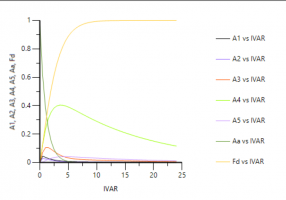Arindam,
bioavailability is specified on the dosepoint for Agut:
dosepoint(Agut, bioavail = (1-Flung), idosevar = AgutDose, infdosevar = AgutInfDose, infratevar = AgutInfRate)
You did limit it already, but it does not seem to work well. I can't tell without the full data/project.
Bernd
Hi Bernd,
I am posting the model code here with initial estimates but not attaching the project as it is done in v. 6.4. Any project run in v.8.0 or more cannot run in system with v.6.4.
test(){
deriv(A1 = - (Cl * C) + (LC1 * KpulC)- (A1 * K12- A2 * K21)- (A1 * K13- A3 * K31) + (LP1 * KpulP) + (Agut * Kgut))
urinecpt(A0 = (Cl * C))
deriv(LC1 = - (LC1 * KpulC)- (LC1 * Kmuc))
deriv(A2 = (A1 * K12- A2 * K21))
deriv(A3 = (A1 * K13- A3 * K31))
deriv(LP1 = - (LP1 * KpulP))
deriv(Agut = - (Agut * Kgut) + (LC1 * Kmuc)- (Agut * Ke1))
urinecpt(A4 = (Agut * Ke1))
C = A1 / V
dosepoint(LC1, tlag = (Tlag), bioavail = (Flung*Fc*Fd1), idosevar = LC1Dose, infdosevar = LC1InfDose, infratevar = LC1InfRate)
error(CEps = 0.1)
observe(CObs = C * (1 + CEps))
dosepoint(LP1, bioavail = (Flung*(1 - Fc)*Fd2), idosevar = LP1Dose, infdosevar = LP1InfDose, infratevar = LP1InfRate)
dosepoint(Agut, bioavail = (1 - Flung), idosevar = AgutDose, infdosevar = AgutInfDose, infratevar = AgutInfRate)
Fd1 = 1-exp(-((t/t63)^b1))
Fd2 = 1-exp(-((t/t60)^b2))
stparm(V = tvV * exp(nV))
stparm(Cl = tvCl * exp(nCl))
stparm(Tlag = tvTlag * exp(nTlag))
stparm(KpulC = tvKpulC * exp(nKpulC))
stparm(K12 = tvK12 * exp(nK12))
stparm(K21 = tvK21 * exp(nK21))
stparm(K13 = tvK13 * exp(nK13))
stparm(K31 = tvK31 * exp(nK31))
stparm(KpulP = tvKpulP * exp(nKpulP))
stparm(Kgut = tvKgut * exp(nKgut))
stparm(Kmuc = tvKmuc * exp(nKmuc))
stparm(Ke1 = tvKe1 * exp(nKe1))
stparm(Flung = tvFlung * exp(nFlung))
stparm(Fc = tvFc * exp(nFc))
stparm(t63 = tvt63 * exp(nt63))
stparm(b1 = tvb1 * exp(nb1))
stparm(t60 = tvt60 * exp(nt60))
stparm(b2 = tvb2 * exp(nb2))
fixef(tvV = c(0, 370000, ))
fixef(tvCl = c(0, 300000, ))
fixef(tvTlag = c(0, 0.33, ))
fixef(tvKpulC = c(0, 0.6, ))
fixef(tvK12 = c(0, 3.3, ))
fixef(tvK21 = c(0, 0.7, ))
fixef(tvK13 = c(0, 1.7, ))
fixef(tvK31 = c(0, 0.11, ))
fixef(tvKpulP = c(0, 6, ))
fixef(tvKgut = c(0, 0.55, ))
fixef(tvKmuc = c(0, 1, ))
fixef(tvKe1 = c(0, 0.1, ))
fixef(tvFlung = c(0, 0.16, ))
fixef(tvFc = c(0, 0.5, ))
fixef(tvt63 = c(0, 1, ))
fixef(tvb1 = c(0, 1.1, ))
fixef(tvt60 = c(0, 0.33, ))
fixef(tvb2 = c(0, 0.7, ))
ranef(diag(nV, nK12, nK21, nK13, nK31, nTlag, nKpulC, nKpulP, nKgut, nKmuc, nKe1, nFlung, nFc, nt63, nb1, nt60, nb2, nCl) = c(1, 1, 1, 1, 1, 1, 1, 1, 1, 1, 1, 1, 1, 1, 1, 1, 1, 1))
}















